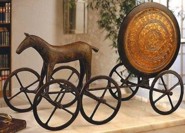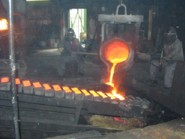BRONZE (CuSn)
History
Bronze, an alloy of copper (Cu) with tin (Zn), already had a great influence on human history 5000 years ago and promoted technical progress. This is why a whole period in history is called the "Bronze Age (2000-800 B.C.). The discovery of a 3500 year old shipwreck at the turkish coast close to Bodrum with 10t of copper and 1t of tin demonstrates that both metals has been produced separately long time ago. Copper alloyed with tin was probably cast for the first time around 2500 B.C., as verified by the famous bronze head from the Near East around 2000 B.C. Even today in this age of bits and bytes, bronze is still an outstanding materia.
|
|
Characteristics
While pure copper is relatively soft, the alloy component tin gives bronze high strength and hardness. In addition, bronze is very corrosion-resistant and wear-proof. Bronze with low tin levels has good thermal and electric conductivity. Bronze also has good spring and gliding properties.As well as tin, the properties of bronze can be controlled specifically by adding other elements such as zinc, nickel and phosphorous. Lead is used to improve machining and gliding properties. Bronze made with the third alloy element zinc plays a special role, constituting the group of copper-tin-zinc cast alloys (red bronze). There is a special aura to bronze, thanks to its warm colour. This makes it interesting for artist craftsmen and graphic art. Bronze with a low tin content resembles the salmon red colour of copper, and changes to brownish red to reddish and greenish yellow shades with increasing tin content.
|
|
Applications / Products
The outstanding combination of properties means that bronze is used in many different ways and can be found in practically all branches of industry: in machine and plant construction, in shipbuilding and power station construction, in the chemicals and food industry, in paper manufacturing, printing and the textiles branch. Bronze is used for example in gears and pumps, for plain bearings, in heavy-duty gear wheels and worm gears, for springs, screws, nuts and bolts, for pipes and tanks. In electronics it is used among others for pin-and-socket connectors, contact strips, relay springs and cable clamps, and serves as a system carrier for semi-conductors. In sanitary applications, bronze (red bronze) is used in particular for fittings and valves. |





